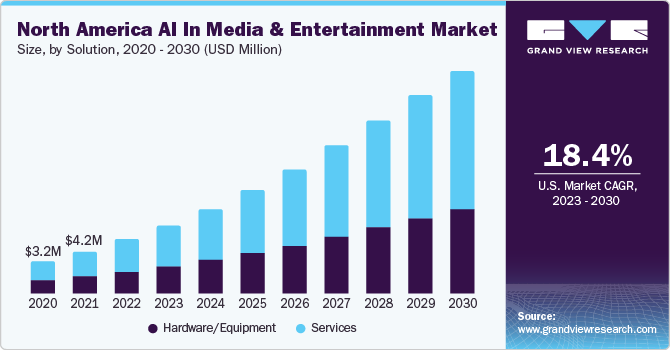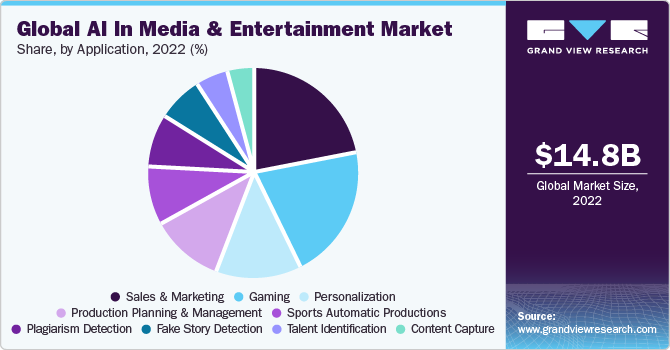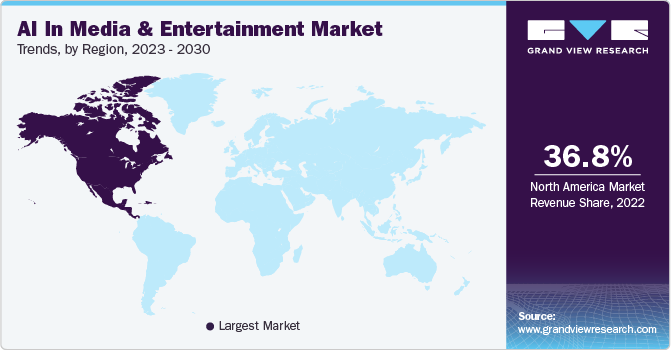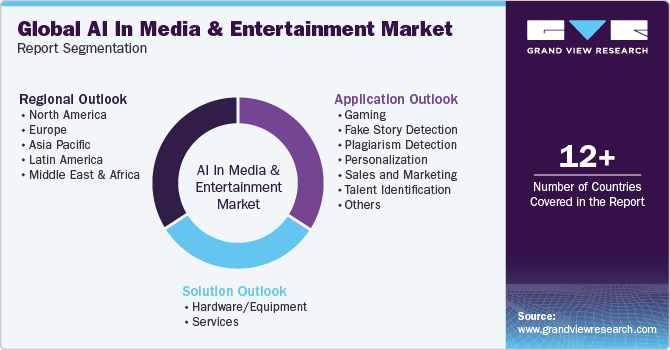- Home
- »
- Next Generation Technologies
- »
-
AI In Media & Entertainment Market Size Report, 2030GVR Report cover
![AI In Media & Entertainment Market Size, Share & Trends Report]()
AI In Media & Entertainment Market Size, Share & Trends Analysis Report By Solution (Hardware/Equipment, Services), By Application (Gaming, Personalization), By Region, And Segment Forecasts, 2023 - 2030
- Report ID: GVR-4-68039-944-3
- Number of Report Pages: 100
- Format: PDF, Horizon Databook
- Historical Range: 2017 - 2021
- Forecast Period: 2023 - 2030
- Industry: Technology
AI In Media & Entertainment Market Trends
The global AI in media & entertainment market size was estimated at USD 14.81 billion in 2022 and is expected to grow at a compound annual growth rate (CAGR) of 26% from 2023 to 2030. Artificial intelligence's use in gameplay, fake story recognition, plagiarized detection, production planning and management, personalization, sales and marketing, talent finding, and other fields is propelling the rise of global AI in the media & entertainment sector. The increasing popularity of virtual creation in the media & entertainment business, and its ability to create high-definition graphics and real-time virtual worlds, are the key factors driving the market growth.

Companies use artificial intelligence to create more tailored services for users by endorsing personalized content following their tastes when users browse a video site and robustness for users with varying Internet speeds and bandwidths. For instance, the prominent platform Netflix has implemented AI technology aiming to create a superior personalized experience for its subscribed consumers. This AI-empowered system will automatically accomplish several machine learning pipelines that offer shows/movies/ program recommendations.
Favorable government initiatives are expected to impact industry growth positively. AI systems are used to recognize objects and behaviors in sporting events. It can also use drone footage to provide broadcasts that include engaging material and in-depth sports analysis. For example, in a football match, AI-generated live footage may capture the adrenaline-fueled action and the players' and fans' responses after each score. Visuals used in the live broadcast of a match should contribute to the construction of an engaging story.
With the rapid adoption of connected devices and sensitive expectations from customers to ongoing competition from internet video streaming providers and social media, several powerful forces are shapeshifting the media & entertainment industry landscape. The integration of AI takes analytics to the next level by applying machine learning algorithms and natural language processing to make sense of vast quantities of data, over 80 percent of which is unstructured. They can help companies leverage building blocks such as dialog capabilities, visual recognition, sentiment analysis, personality insights, and tone analysis to help drive competitive benefits.
Solution Insights
The service segment dominated the market, with a revenue share of 59.5%% in 2022. The rising applications of computer-generated graphics and visual effects in commercial advertisements and movies are anticipated to influence market growth positively. Furthermore, continuing technological progressions in AI-based technologies enable the advancement of engaging content with the incorporation of advanced visual effect structures. The service segment is projected to witness the fastest growth on account of the lack of trained professionals in virtual production and VFX technology, film studios or moviemakers often hire qualified agencies and their services to implement VFX in their video productions.
The hardware segment is projected to expand with a prominent growth rate over the forecast period. This can be accredited to the significant increase in the requirement for real-time background visuals essential for in-house shoots. The AI ecosystem has been increasing, targeted problems are getting more complicated, and AI-specific hardware components are being introduced to address the complex issues for various applications. The increasing use of AI-based virtual production technology in movie studios and TV shows is expected to boost the demand for motion capture workstations, virtual camera systems, simulation cameras, and other virtual production hardware in the near future.
Application Insights
The sales and marketing segment dominated the market, with a revenue share of 21.8% in 2022. AI is used for trading or marketing aspects, including design, advertising, and promotions in the media & entertainment fields. Smart AI work-frames can develop creative marketing and advertising solutions. The personalization segment has been witnessing substantial growth in the recent few years. Leading music and video streaming platforms such as Spotify and Netflix are also successful because they provide various user preferences and tastes for audiences from across the globe.
Artificial intelligence is also gaining prominence in automated sports productions with improved precision and efficiency for live streaming, broadcasting, and analytical services. With the implementation of sophisticated sports automatic production technology, the creation of footage can be completed faster. Furthermore, the gaming segment accounts for a prominent chunk of the revenue share. AI is generally used in games for controlling non-player characters (NPCs). AI analyzes players’ actions to forecast their next movements, and AI models also determine changes in a gamer’s behavior in specific scenarios.

The video production segment in sports automatic production led the market with a revenue share of 43.3% in 2022. The major reason for the growth is that AI offers a platform for automating tasks, including script breakdown, storyboarding, and shot lists generation, scheduling, and budget management. AI-based software can also automatically group and synchronize recorded clips. With further advancements, AI will be able to create content autonomously. Using Artificial Intelligence, predictive analytics can perform marketing procedures faster. Marketing software driven by AI helps create promotional approaches, address audience goals, and make effective customer solutions.
With the initiation of advanced technologies such as artificial intelligence, virtual production technology is witnessing substantial enhancements in its computer-generated graphics. Designing and visualizing all complex scenes in a three-dimensional model has become convenient, further editing and review in real-time. Furthermore, artificial intelligence offers pre-production assistance, which accelerates video creation. Artificial intelligence can create perceptions from large data sets gathered from several platforms for understanding the proposed content's interest and acceptance. For instance, Netflix creates video material based on exact, customized suggestions and observations of its users' behavior, such as browsing history, interest, and data actions, such as pausing or rewinding videos.
Regional Insights
The North American region led the market with a revenue share of 36.8% in 2022. Significant investments by the companies in research & development for creating AI-based virtual production software solutions also ascend the regional market's growth. Voice & speech recognition using AI is one of the most significant trends witnessed in the region. For instance, Sonos Inc., a US-based audio firm, received the dialect and accent audio collection from Globalme Localization Inc., a US-based AI startup. Sonos Inc. collected accents and voice data from three nations to integrate intelligent home assistants with its wireless speakers. This integration enabled the organization to fine-tune its voice recognition engines, leading to a better voice experience.

South America is expected to witness a prominent growth rate over the forecast period. The companies in the region are capitalizing on initiatives to implement AI technologies in the future. For instance, Inamika Interactive, a company located in Mendoza city in Argentina, has already implemented AI and virtual reality. It has developed a virtual reality tour of the Museum of Mendoza’s dinosaur exhibit.
Key Companies & Market Share Insights
The market is categorized by intense competition, with only a few major worldwide firms controlling a significant portion of the market. Key players emphasize new product developments and alliances as options for higher profitability through improved client interactions. For instance, in February 2023, Krikey.ai and Stability AI, two businesses that specialize in producing AI-powered services and applications, partnered to enable their users to produce animated avatar videos using text descriptions that can be downloaded and shared on social media, through video editing software, or 3D video games. Similarly, in March 2023, Metagame Industries and Mysten Labs announced their partnership agreement. Through this partnership, they launched a new online action video game named Abyss World featuring role-playing elements.
Key AI in Media & Entertainment Companies:
- Amazon Web Services, Inc.
- EMG
- Gearhouse South Africa PTY Limited
- Gravity Media
- GrayMeta
- International Business Machines Corporation
- LMG, LLC
- Matchroom Sport Ltd
- Production Resource Group, L.L.C.
- Synthesia Ltd
- TAIT
- Valossa Labs Ltd.
- Veritone, Inc.
- Pixellot
- PlaySight Interactive LTD
- AISportsWatch GmbH
- Spiideo
- Sportway AB
- EVS Broadcast Equipment S.A.
- Hudl
- Move.ai
- AutomaticTV
AI In Media & Entertainment Market Report Scope
Report Attribute
Details
Market size value in 2023
USD 19.75 billion
Revenue forecast in 2030
USD 99.48 billion
Growth rate
CAGR of 26% from 2023 to 2030
Base year for estimation
2022
Historical data
2017 - 2021
Forecast period
2023 - 2030
Report Updated
December 2023
Quantitative units
Revenue in USD million/billion and CAGR from 2023 to 2030
Report coverage
Revenue forecast, company ranking, competitive landscape, growth factors, and trends
Segments covered
Solution, application, region
Regional scope
North America; Europe; Asia Pacific; South America; MEA
Country scope
U.S.; Canada; UK; Germany; France; China; Japan; India; South Korea; Australia; Brazil; Mexico; KSA; UAE; South Africa
Key companies profiled
Amazon Web Services, Inc; EMG; Gearhouse South Africa PTY Limited; Gravity Media; GrayMeta; International Business Machines Corporation; LMG, LLC; Matchroom Sport Ltd; Production Resource Group, L.L.C.; Synthesia Ltd; TAIT; Valossa Labs Ltd.; Veritone, Inc.; Pixellot; PlaySight Interactive LTD; AISportsWatch GmbH; Spiideo; Sportway AB; EVS Broadcast Equipment S.A.; Hudl; Move.ai; AutomaticTV
Customization scope
Free report customization (equivalent up to 8 analysts working days) with purchase. Addition or alteration to country, regional, and segment scope.
Pricing and purchase options
Avail customized purchase options to meet your exact research needs. Explore purchase options
Global AI In Media & Entertainment Market Report Segmentation
This report forecasts revenue growth at global, regional, and country levels and provides an analysis of the industry trends in each of the sub-segments from 2017 to 2030. For this study, Grand View Research has segmented the global AI in media & entertainment market report based on solution, application, and region:

-
Solution Outlook (Revenue, USD Million, 2017 - 2030)
-
Hardware/Equipment
-
Services
-
-
Application Outlook (Revenue, USD Million, 2017 - 2030)
-
Gaming
-
Fake Story Detection
-
Plagiarism Detection
-
Personalization
-
Production Planning and Management
-
Sales and Marketing
-
Talent Identification
-
Content Capture
-
Sports Automatic Productions
-
Video Production
-
Broadcasting & Live Streaming
-
Analytics
-
-
-
Regional Outlook (Revenue, USD Million, 2017 - 2030)
-
North America
-
U.S.
-
Canada
-
-
Europe
-
UK
-
Germany
-
France
-
-
Asia Pacific
-
China
-
Japan
-
India
-
South Korea
-
Australia
-
-
Latin America
-
Brazil
-
Mexico
-
-
Middle East and Africa
-
UAE
-
Saudi Arabia
-
South Africa
-
-
Frequently Asked Questions About This Report
b. The global AI in media & entertainment market size was estimated at USD 14.81 billion in 2022 and is expected to reach USD 19.75 billion in 2023.
b. The global in media & entertainment market is expected to grow at a compound annual growth rate of 26.0% from 2023 to 2030 to reach USD 99.48 billion by 2030.
b. North America dominated the AI in media & entertainment market with a share of 36.8% in 2022. This is attributable to significant investments by the companies in research & development for creating AI-based virtual production software solutions.
b. Some key players operating in the AI in media & entertainment market include Amazon Web Services, Inc; EMG; Gearhouse South Africa PTY Limited; Gravity Media; GrayMeta; International Business Machines Corporation; LMG, LLC; Matchroom Sport Ltd; Production Resource Group, L.L.C.; Synthesia Ltd; TAIT; Valossa Labs Ltd.; Veritone, Inc.; Pixellot; PlaySight Interactive LTD; AISportsWatch GmbH; Spiideo; Sportway AB; EVS Broadcast Equipment S.A.; Hudl; Move.ai; AutomaticTV.
b. Key factors driving the AI in media & entertainment market growth include cognitive opportunity in media and entertainment, automated content creation to improve workflow efficiency, and innovation and advancements in technology.
Share this report with your colleague or friend.
![gvr icn]()
NEED A CUSTOM REPORT?
We can customize every report - free of charge - including purchasing stand-alone sections or country-level reports, as well as offer affordable discounts for start-ups & universities. Contact us now
![Certified Icon]()
We are GDPR and CCPA compliant! Your transaction & personal information is safe and secure. For more details, please read our privacy policy.
We are committed towards customer satisfaction, and quality service.
"The quality of research they have done for us has been excellent."





